Contents
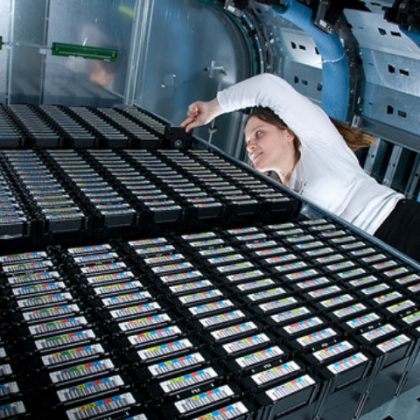
Introduction
Despite the inroads made in large-scale disk backup and backup to cloud strategies, magnetic tape backup software remains a significant component of many data protection architectures. Tape provides advantages that set it apart from any other technology. Factors such as data write speed, portability, reliability, relatively low CO2 footprint, ease of storage, and data density all contribute to the ongoing popularity of tapes.
Bacula Enterprise supports tape libraries of all vendors, sizes, and types, in addition to cloud and disk backup, giving the customer total flexibility in storage media – and for most organizations’ future storage needs, flexibility is key. This how-to blog will describe some basic setup steps and configuration notes for using tape backup software solutions for most libraries from Bacula Enterprise.
Tape, disk, and cloud storage types
Disks are a well-known storage medium requiring little to no maintenance, and their scalability is generally reasonable. One of their main advantages is recovery time – normally allowing for faster access to specific files from your backup. This is perhaps even more the case when considering the advantages of deduplication, which is essentially the deletion of all duplicated data at a highly granular level, so your backups typically take much less storage space.
However, there are also disadvantages regarding using disks as data storage. For example, data kept on disks may be more susceptible to accidental overwrite or deletion and can become a target of specific computer viruses. Disks can also be relatively costly when it comes to upkeep since they’re always “working” and can become overheated, which means you’ll need both a means of cooling and providing power for the whole system to work correctly. Similarly, the “always on” state of disks mean that their sustainability qualifications can be criticized.
At the same time, some people might think that relying on cloud backups would solve those problems – but cloud storage quite often uses the same disk types as everyone else – merely providing you with access to them. This means most of these issues remain.
Of course, cloud storage as a backup target has its benefits. For example:
- Convenience is essential since cloud backups can be accessed from any location with an internet connection. In some circumstances, this can make it easier for the IT department to manage all backup and restore operations.
- Accessibility is also a point of interest in cloud backups since they may allow certain end-users to avoid travel restrictions, for example lockdown orders and many others. Cloud data can be accessed via an app or the web browser from any geographical location with an Internet connection.
- Snapshot capability is a convenient feature since cloud backup can make it easier to generate and store snapshots for various purposes.
The importance of tape
Tape has been a part of the choice of storage for almost as long as computing has been around. Modern tape technology is highly reliable and has significant security qualities to be considered a primary storage possibility in many cases. This fact however, is not necessarily appreciated by a significant portion of the industry. One of the clear advantages of tape is its capacity-to-cost – the LTO-9 standard allows for up to 45 TB data per single tape unit (and the future standard LTO-12 promises to reach an overall capacity of up to 480 TB per tape).
Price alone is a crucial point. Tape is considered one of the cheapest storage choices for long-term data storage. It is used in some cloud services, too, and the offsite vaulting of tape, in general, may well allow stored data to escape the ramifications of a natural disaster or some other type of occurrence that might harm your data on-site.
The tape is also a perfect storage type for air gapping. Air Gapping means a complete lack of connections with any network, making it virtually impossible to infect or corrupt the storage. Since tape is more suited for long-term storage, and tape libraries can be turned off when not needed – tape is a perfect place for an air-gapped copy of a company’s sensitive data.
Complexity can sometimes be relevant to tape backups – the entire process can sometimes require constant surveillance, thorough planning of the whole process, and the use of a function called a backup rotation scheme. This is a system of backing up data to computer media – and tape can be key here – that minimizes, by aiming to re-use the number of media used. The scheme determines when and how each piece of removable storage is used for a backup job and how long it is retained once it has backup data stored on it.
Tape backup rotation schemes
Occasionally, you may need a new tape cartridge for every backup cycle. Reusing tape cartridges from previous backups is also possible, making it a much more cost-effective approach. Generally speaking, it is possible to segregate three primary backup rotation schemes in tape backups:
- GFS scheme. The most reliable option, the Grandfather-Father-Son scheme, is the most popular backup rotation scheme. It relies on keeping multiple levels of backups, from daily to weekly and monthly backups. One potential issue with this approach is that it is the least cost-effective of the choices, requiring more tape to execute appropriately, thus potentially generating a higher upkeep cost for the company.
- Tower of Hanoi. A backup rotation scheme that acts as a middle ground between the most expensive and the most affordable ones is called the Tower of Hanoi. This scheme is best for small or medium-sized businesses with small data volumes. While it does cost less than the GFS scheme, it is also complicated in its implementation, creating a high possibility for an error to be made when swapping tape cartridges. Additionally, this rotation scheme requires a full backup for each session, making the entire process long and storage-intensive.
- Five-tape scheme. The five-tape rotation scheme is the most cost-effective option, and it is at its best when used for smaller businesses that do not require archiving outdated information. It works on a relatively simple principle of reusing tape cartridges weekly, keeping one tape cartridge for every working day. It is worth noting that, for this rotation scheme to work, the company’s daily data volume should not exceed a single tape cartridge’s capacity.
Proper upkeep conditions will allow the tape to stay sound for a long time without damaging the data in question. The general tape lifespan is considered to be around 30 years. There’s also the nature of tape backups – they aren’t “plugged in”; as soon as the backup is done – the device itself goes offline, and that saves the data within from potential cyberattacks and other threats.
The benefits of using tape backup
Some people may question the reasons for using tape in general when many are moving away from physical storage to the cloud. There are several reasons for that:
- Durability – as mentioned before, tape can store data for about 30 years with proper care, which is a significant amount of time without regular maintenance. This is much more than any other storage type: SSD or HDD.
- Security – modern tape formats like LTO-Ultrium offer data encryption over tape to ensure compliance with all kinds of laws and standards regarding data security. Knowing where your tape backup is stored is also considered a significant advantage when it comes to the requirement of physical control over a company’s data. There is also the ability to make tape storage air-gapped by turning it off, disconnecting it from the outside network completely – and removing any possibility of an attack angle being used digitally.
- Portability – despite its capacity in general, tape is easy to store, especially when compared to cloud systems or hard drives.
- Conversion prices – some older companies don’t have the funds to migrate to another data storage medium or include another one alongside tape. Complete data storage conversions mostly require an incredible amount of work and funding; add to that all the work about policy changes – and it’ll be a good enough reason for companies to continue using tape despite everything.
- Compliance – some organizations, for example, banks and legal institutions, find it easier to use tape to meet compliance laws and obligations.
- Sustainability – many organizations, especially larger ones, are becoming more serious in actually executing on their sustainability guidelines. Tape scores highly in this regard, and more information on sustainability of tape and other backup-related technologies is available on request from Bacula Systems.
Potential disadvantages of tape backup
- Specific conditions for long-term upkeep – The tape storage isn’t perfect. Like disk-based media, it requires specific requirements to prevent data deterioration. Regular physical cleaning is necessary to avoid tape contamination via dust, dirt, or fiber particles. Cleaning too often is also not recommended since it may provoke tape degradation.
- Low performance – General recovery times for tape are typically longer than most of the alternatives due to the need to physically get the tape in question to your working environment, and navigation within that data has more limitations than disk. Even with the most recent developments, such as linear tape file systems (LTFS) – it’s still nowhere close to that of disk searching speed.
- Incorrect tape media – Tape is also prone to numerous issues, such as incorrect tape media. For example, using an unprepared or unrecognized tape media is a surprisingly common mistake in this field. Fortunately, the tape backup software should be able to notify its user if it manages to locate one or more cartridges like this. All of this is possible thanks to a unique barcode that each tape cartridge has.
- Magnetic waves – Tape storage is sensitive to magnetic waves, and it is the only storage type that reacts to them. Prolonged exposure can damage both the tape storage and the data it keeps.
- No random access – Tape only supports sequential access, requiring the tape medium to physically rewind itself to find the necessary location for restoration or another task.
- Invalid backups & lack of testing – Tape backup testing is unpopular, with roughly 34% of businesses failing to test their tape backups, and about 77% of the ones that tried their backups and found some sort of tape-related backup issues (source). The risk of creating an incorrect or invalid backup without knowing it is always there, which is why it is crucial to perform regular error checks, as well as a routine backup verification process, regular test restores, and a stable full backup (at least once a month) – all of that is done to minimize the potential damage of losing some, if not all, of your primary data.
Despite its limitations, tape is still considered one of the most appropriate storage types when it comes to long-term data storage – and in that regard, tape prevails over most of the alternatives.
Tape backup misconceptions
There are some common misconceptions about the tape. We’ll review some of the most popular ones:
- The tape backup is dead. The only thing dead about the tape as a backup medium is the marketing efforts! Plenty of companies still use tape in their backup systems. The lack of general understanding of the technology behind tape as a storage type prevents people from realizing the possible benefits of using tape as a backup storage medium. Partial blame can be laid upon tape vendors; they do little to educate against negative rumors and misconceptions.
- Tape, as a storage medium, can be replaced. There are specific tape benefits that no other storage type can match as quickly. High capacity is one of those. Keeping large amounts of data on tape is considerably cheaper than using any other medium. Many companies prefer tape to the cloud to store their data simultaneously intact and offsite for compliance purposes. The tape’s offline capabilities allow it to evade most of the cyber threats of the modern age. They also require less power and generate less heat than other storage types like disks.This quality is becoming increasingly important in the context of limiting CO2 footprints.
- Tape is ineffective as a storage. While tape has some limitations, it is perfect for offsite data storage and plays its part in long-term data retention. There’s a well-known strategy for backups called the 3-2-1 rule: where you should keep three different copies of your data stored within at least two different types of storage, and at least one backup copy must be stored off-site. Tape backups are a perfect medium for playing a part in that strategy, since its storage capabilities are enormous, and when used as offline storage, make it almost impenetrable by modern cyber threats.
- Tape, as a data storage technology, is old and outdated. It’s worth remembering that tape is the only storage medium that has been stable since it was created with fewer rises or declines in popularity, like disk or cloud storage experiences. Modern tape technology, and its performance statistics are actually especially impressive.
- There is no future for tape backups. Due to tape’s reputation as a “dead” storage type, some people think it’s not evolving and has no future. This statement is not true; over 80% of modern companies of different sizes use tape backup as one of their means of storing data. Moreover, recent years have shown an increase in this technology. Meanwhile, tape manufacturers continue to significantly improve tape and its associated technologies as a storage medium. This concerns capacity, data encryption within the tape, data partition (to lessen the overall backup complexity), and other optimization technologies.
Tape modernization
Why modernize a tape backup structure?
Tape storage is well-known for its capacity and security, compensated with a slower data recovery speed. Performance is a necessary parameter in a modern environment, so there is always a demand for more speed and efficiency.
Tape backup modernization in this context is not exactly a direct upgrade of a tape technology but rather a complete data migration from one storage type to another. Companies can use this to receive advantages such as reduced data upkeep and increased performance.
An example of how tape storage modernization can be performed
It is not possible to just copy and paste existing data from one platform to another. This migration process incorporates multiple stages, including recommendations and requirements for the tape backup modernization to succeed.
- Review data protection policies that are currently active.
The majority of backed-up data is protected using security policies. This is practically necessary to prevent threats such as data loss or cyberattacks. The review process allows for outdated policies to be discarded or updated while ensuring that no protection policy would interfere with the data migration process in some way.
- Organize the tape library.
It is not uncommon for tape storage facilities to not have a manifested order due to the lack of regular human interactions with them. It usually means some storage parts are problematic – not labeled, afflicted, or outright destroyed. Organizing and cataloging all the tape data before migration is an excellent way to prevent data loss during the transfer.
- Validate all the tape data.
Not having regular visibility into data changes in tape backups is also a relatively common situation. It is recommended that IT teams review backups regularly to make sure the data is protected and complete. Validation and regular cleanup are essential for proper tape storage use.
- Coordinate the upcoming data migration with security staff.
Tape stores an exuberant amount of data in most cases. Transferring data from one tape storage to another creates a large and prolonged data stream that must be protected to ensure no tampering. Add that to the fact that data mid-transfer is more vulnerable to cyberattacks, and it becomes obvious why the IT security team should be aware of the migration process beforehand.
- Choose a strategy for the migration process.
The migration process can be initiated as soon as all the steps above are complete. There are three main tape data migration strategies – Tape-to-On-Premise, Tape-to-Cloud, and Hybrid.
Tape-to-On-Premise migration that is bound by regulatory or security concerns, with a requirement of moving data from offsite backup storage to an on-premise infrastructure.
Tape-to-Cloud migration is a common alternative to the previous migration method, transferring the entire tape data framework to cloud storage. It can be used for data that is often necessary at a moment’s notice, and cloud storage can be accessed easily, which is not comparable to tape’s operation speed. This method reduces long-term ownership costs but also introduces significant short-term expenses.
Hybrid migration is the proverbial “best of both worlds” situation, where data is transferred to on-site and cloud storage. It represents a combination of reliability and performance and may be convenient for a select group of users.
It should be noted that this is not the traditional meaning of tape modernization, and it does not mean that tape storage does not have its share of use cases and advantages.
Tape storage best practices
Tape storage can be picky regarding the environment it needs to be stored in. We can summarize the tape’s best practices in a single phrase – physical care with backup inventory and task monitoring. This statement is also not descriptive enough to be useful, which is why you will find several best practices for tape storage below.
- Think through the optimal geographical location for tape backup storage.
- Perform semi-regular cleaning of tape cartridges.
- Test tape recoverability regularly.
- Use antivirus software on your workstations when possible.
- Keep track of who has access to tape backups.
- Do not assume that tape backup is completely protected; always use multiple storage locations.
- Review and use all the regulations prescribed for magnetic tape upkeep.
- Maintain a strict record of tapes and tape libraries available.
- Create a backup strategy that custom-fits your company’s needs.
- Make sure not to use incorrect tape devices for tape cartridges.
Methodology for picking the best tape backup software
The backup software market is highly competitive and contains many solutions with very similar feature sets. Navigating this market and picking a single solution can be surprisingly difficult. One of the goals of this article is to try to make this process easier. Below, we will review multiple examples of tape backup solutions that we consider some of the best in the field. But first, we have to present our methodology on how these solutions were chosen.
Customer rating
The customer rating directly represents the subject’s average market situation – if the product is liked or disliked. The subject in question is tape backup software – and there are plenty of examples of this software type. In our example, this is one of the easiest ways to showcase public opinion about a specific topic – a tape backup solution. Resources such as G2, TrustRadius, and Capterra were used to gather this information.
Capterra is a review aggregator platform that offers verified reviews, guidance, insights, and solution comparisons. Their customers are thoroughly checked for the fact that they are, in fact, real customers of the solution in question, and there is no option for vendors to remove customer reviews. Capterra holds over 2 million verified reviews in almost a thousand different categories, making it a great option for finding all kinds of reviews about a specific product.
TrustRadius is a review platform that proclaims its commitment to truth. It uses a multistep process to ensure review authenticity, and every single review is also vetted to be detailed, deep, and thorough by the company’s Research Team. There is no way for vendors to hide or delete user reviews in one way or another.
G2 is another excellent example of a review aggregator platform that boasts over 2.4 million verified reviews, with over 100,000 different vendors presented. G2 has a validation system for user reviews that is claimed to be highly effective in proving that every single review is authentic and genuine. The platform also offers separate services for marketing purposes, investing, tracking, and more.
Advantages/disadvantages and key features
There are plenty of different solutions that support tape backups somehow. However, most of the features they offer are standard capabilities of a backup solution applied in the context of tape. The same goes for advantages and disadvantages – they regularly repeat one another. We have several preferred vital features:
- Data encryption capabilities.
- Data deduplication features.
- Support for multiple backup types.
- Easy tape storage management capabilities.
- Support for other workload types.
These are some of the most common features of a tape backup solution. This list is incomplete, and many other capabilities may be present in one or several solutions as well.
Pricing
A solution’s features are essential to the end user, but the topic of price is just as important. Some companies have a minimal budget, and others need a specific feature set no matter the price, but most potential clients fit somewhere between these two. It is highly recommended to check both the price and the feature set of the solution while also weighing it against another – even if the solution is within your budget, it may not be as good of a deal on a per-feature basis as its competition.
A personal opinion of the author
The only completely subjective part of this methodology is the author’s opinion on the subject (tape backup solution, in this case). There are plenty of different use cases for this particular category, including interesting information about the solution that did not fit in any of the previous categories or just the author’s personal opinion about this specific topic.
Providers of tape backup software
Tape backup is supported by many third-party backup software providers, even if it may not be apparent at first glance. In the list below, you can see eight different examples of backup software providers that can work with tape backup and restore operations:
Commvault Cloud
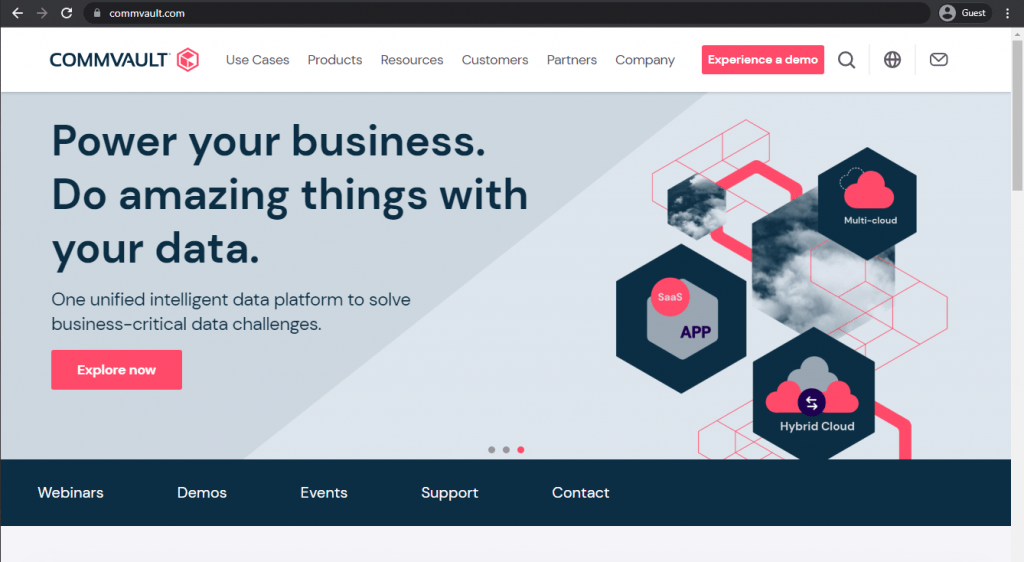
Commvault Cloud (previously known as Commvault Backup and Recovery) is a popular backup solution that also supports backup to tape – including procedures such as tape discovery, tape loading/unloading, and tape deletion. Additionally, two of Commvault’s features can be applied to tape backup. There’s the Export Media – the ability to physically remove media from the tape storage and the Vault Tracker – the ability to manage media stored on offsite locations (the primary use case for tape backups in general).
Customer ratings:
- Capterra – 4.5/5 points with 36 customer reviews
- TrustRadius – 8.0/10 points with 217 customer reviews
- G2 – 4.3/5 points with 134 customer reviews
Advantages:
- Easy integration into different business infrastructures.
- Capability to operate in tandem with other solutions, if necessary.
- Backup configuration is easy to work with.
Disadvantages:
- The software is often regarded as overly complicated and not particularly user-friendly.
- There is no official pricing data that could be found publicly, but plenty of customers note the overall high price of the solution.
- The reporting and logging capabilities of the software are rigid and lack most customization options.
Pricing (at the time of writing):
- No pricing information can be found on Commvault’s official website.
- Contacting the company directly is the only option for receiving such information.
- The unofficial information suggests that Commvault’s hardware appliances’ are sold for $3,400 to $8,781 monthly.
My personal opinion on Commvault:
Commvault is a highly versatile solution, as it can support a wide range of storage options in cloud or physical environments. It doesn’t matter where your data is stored, whether in traditional on-premises infrastructure or in the cloud; Commvault guarantees protection and accessibility for internal documents and other data formats. Commvault can offer a standard feature set for tape backups, including loading, removal, unloading, and discovery. It can be an attractive option for larger companies, but smaller businesses may struggle greatly with Commvault’s overall price and rigidity in some areas.
Arcserve
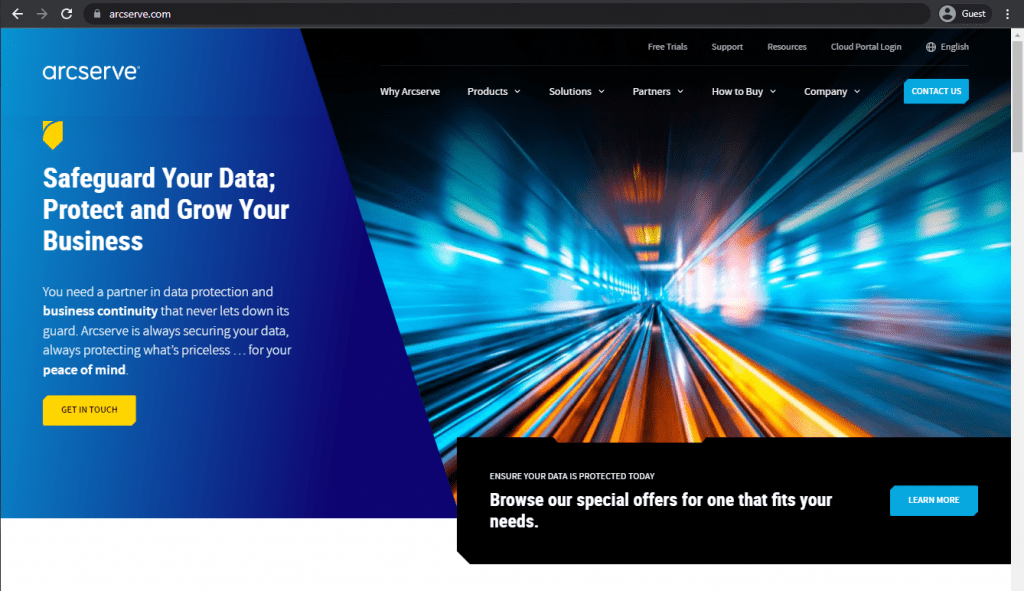
Arcserve is a data protection solution offering multiple plans to clients, each more suitable for a specific target audience. Its tape backup solution capabilities are more suitable for data centers, offering various features to counteract some expected tape problems. As such, Arcserve provides centralized reporting (SRM), granular recovery for numerous instances, innovative restore capabilities, and also meets the requirements for various backup-specific tactics, such as D2D2T, D2D2C, and VTL.
Customer ratings:
- TrustRadius – 5.5/10 points with 50 customer reviews
- G2 – 4.3/5 points with 16 customer reviews
Advantages:
- Capability to offer complex backup schemes (disk-to-disk-to-tape, for example).
- Many features, including hardware snapshots, virtual tape libraries, and multiplexing.
- Centralized access to different storage and backup types using a convenient dashboard.
Disadvantages:
- Manual troubleshooting is complex because Arcserve’s logging system is not descriptive enough.
- The solution tends to get extremely expensive for more extensive and more varied companies due to the need to purchase individual licenses for every device in the system.
- Updating the software is sometimes far from convenient.
Pricing (at the time of writing):
- There is no information about Arcserve’s pricing on the official website.
- Contacting the company directly seems to be the best way to receive such information.
My personal opinion on Arcserve:
Arcserve’s solution implements many features that are considered traditional. It mainly focuses on creating backups for physical storage while also supporting other storage types. Arcserve offers centralization features and a variety of unique backup capabilities – granular recovery, centralized reporting, and support for various backup schemes that use tape. Although it is an old-school solution, it is still quite an exciting option that may be worth considering in specific use cases.
Veeam
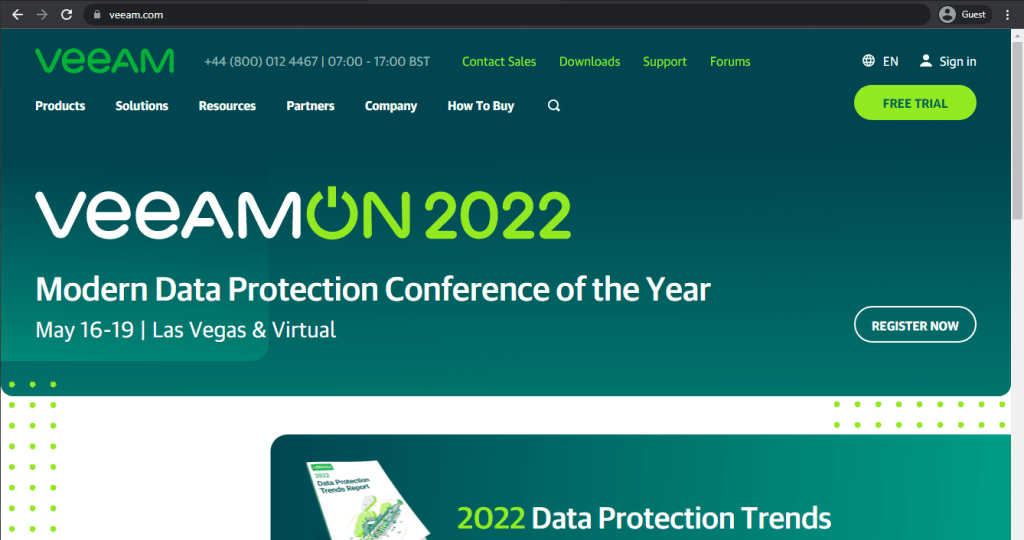
An excellent example of a well-known backup platform on the market that works as a tape backup software. Veeam does have some abilities in terms of tape backup including Windows servers, Linux servers, NDMP, and NAS devices. It supports both full and incremental backup types and has specific “backup to tape” jobs that offer more options for tape as the backup target storage specifically.
Customer ratings:
- Capterra – 4.8/5 points with 73 customer reviews
- TrustRadius – 8.9/10 points with 1,575 customer reviews
- G2 – 4.6/5 points with 593 customer reviews
Advantages:
- Most of the software’s features have a simple setup process. This includes backup and recovery tasks.
- Veeam’s customer support team is outstanding, and the community around the solution is helpful.
- A centralized dashboard makes managing multiple backup and storage types easier with minimal effort.
Disadvantages:
- Troubleshooting can be tricky with Veeam due to the software’s lack of detailed error messages.
- Veeam can offer many different features for a backup solution, but it cannot be good at everything. Data management and cyber resiliency are some of the most obvious weak spots of the software.
- Veeam is an expensive solution. Most SMBs cannot afford it at all, meaning that it primarily targets large-scale enterprises by default.
- Veeam’s core technology does not particularly lend itself to tape backup approaches, and it also has limited compatibility with some tape technologies. Care is advised here.
Pricing (at the time of writing):
- No pricing information can be found on the official Veeam website.
- There is a pricing calculator page that makes it possible to create a more specialized customer request according to a client’s needs.
My personal opinion on Veeam:
Veeam is one of the most well-known backup solutions on the market, but it has limitations especially when it comes to tape-based storage mediums. It has managed to build a sizable client base over the years. Veeam always strives to improve its solutions by introducing new features and capabilities. Its most significant marketing point is VM backup, but it can also work with some other storage types – such as tape, database, app data, and cloud storage. Security levels are perhaps not as high as with other backup software vendors. Veeam is not known for being a cheap solution; most of its clients realize it, but the convenience of its hypervisor-centric feature set are enough of a reason to its customers to justify a high price tag.
BackupAssist
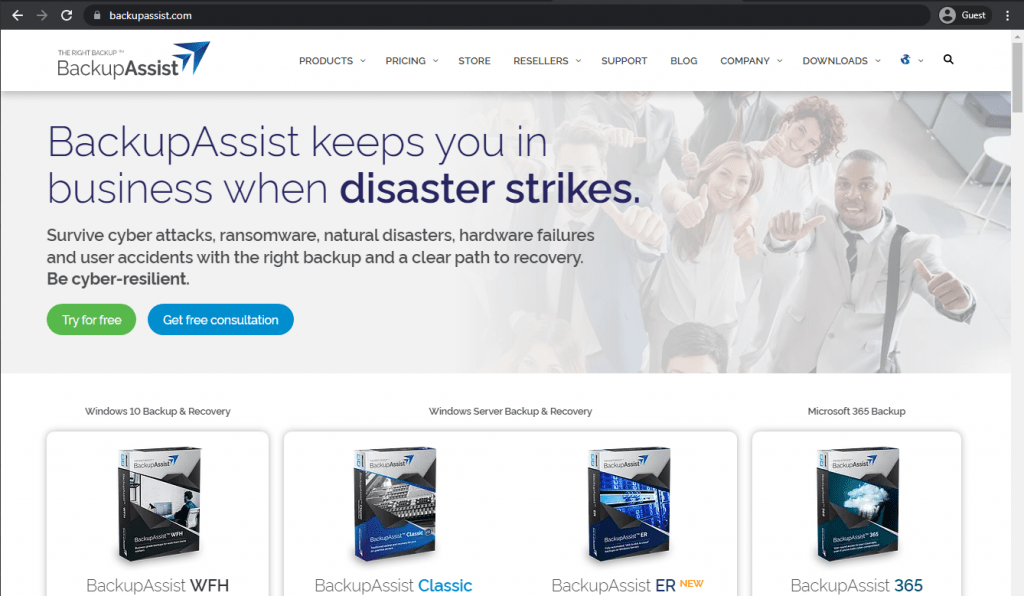
BackupAssist lives up to its name, offering a comprehensive backup solution for Windows Server, Microsoft 365, and work-from-home environments. Its BackupAssist Classic package provides an abundance of features for data protection, and it is also the only option that supports tape backup. BackupAssist has an impressive list of features when it comes to server tape backups, such as data encryption (AES-256), tape labeling, full/incremental/differential backup support, data compression, quick and easy installation/management, multiple notification methods, and more.
Key features:
- Being a backup solution with a self-explanatory name, BackupAssist can help companies struggling with performing primary backups for their business data.
- The software can offer multiple backup types – differential, incremental, and full.
- Other features of BackupAssist include data encryption, data compression, extensive notification system, and support for many environment types.
- Most features of the solution also apply to tape storage, including backup types, data compression, and data encryption.
Pricing (at the time of writing):
- BackupAssist Classic is the only software version supporting tape as a backup target.
- BackupAssist has a straightforward pricing model with two positions.
- $425 for the entire feature set of BackupAssist along with BackupCare – 12 months of software upgrades, ransomware protection, and personalized customer support.
- $530 for virtually the same package, but for 24 months instead of 12.
My personal opinion on BackupAssist:
BackupAssist is not a well-known backup solution. That does not mean that it is not practical. The solution can offer a variety of features to assist its users with backup and recovery tasks (staying true to its naming). It can offer compression/encryption, several backup types, support for plenty of storage variations, and an extensive notification system. BackupAssist Classic is the only version of the solution that also offers tape support, with most of the software’s features applying to tape storage. However, there are limitations in terms of manufacturer compatibility.
NovaStor
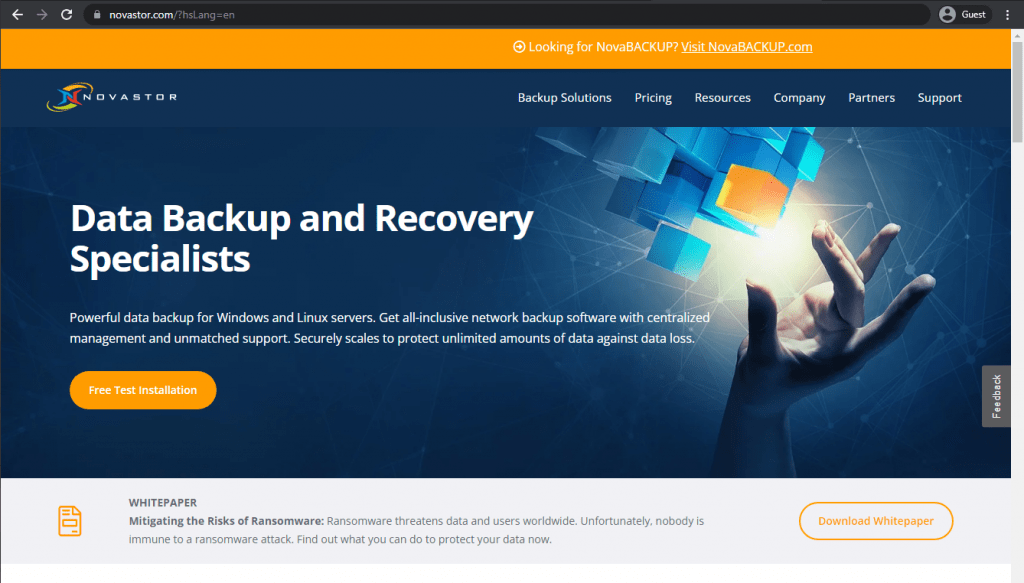
Moving on to smaller backup solutions, NovaStor offers a comprehensive backup solution with an impressive feature set. It supports Windows, Linux, and VM workloads, capable of operating with SharePoint, Active Directory, and MS Exchange. There are also multiple features worthy of an excellent server tape backup solution, such as virtual tape libraries, cloud storage support with multiple storage providers, deduplication, and dynamic tape drive sharing.
Key features:
- NovaStor supports various workload types, including applications, databases, AD, and regular servers.
- The solution works well with tape drivers as backup storage, providing data deduplication, dynamic tape drive sharing, and virtual tape libraries.
- The main focus of NovaStor is middle-sized and large businesses, making it less than suitable for smaller companies.
Pricing (at the time of writing):
- NovaStor DataCenter has straightforward data-based pricing.
- $2,500 per year is offered for up to five terabytes counted as FETB (Front-End Terabyte – the amount of data stored in a source location).
- $4,500 per year supports up to ten FETB.
- $9,500 per year works for up to twenty-five FETB.
- There is also the custom licensing option, which only applies when the customer’s needs exceed twenty-five terabytes of front-end data.
My personal opinion on NovaStor:
NovaStor is a lesser-known backup solution with a decent feature set. It supports many storage types, such as AD, Exchange, SharePoint, VMs, databases, Windows and Linux workloads, and some types of tape. NovaStor supports cloud storage with multiple storage options, virtual tape libraries, dynamic tape drive sharing, and data deduplication. It is a decent solution with a licensing model that calculates its price based on the amount of front-end data processed, which is not the most favorable option for some users.
Iperius Backup
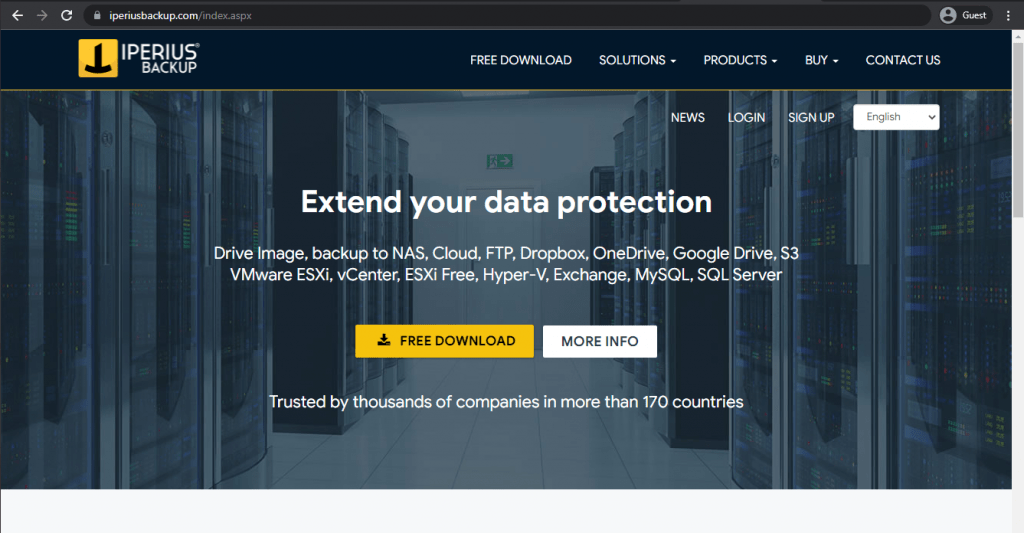
Many tape-specific features can also be found in Iperius Backup, a backup solution for databases, virtual machines, and other workloads. As for the tape-related features that Iperius Backup can offer – there’s drive imaging, data encryption, support for VSS (Volume Shadow Copy), support for all the different tape drive variations (LTO tape backup, as well as DLT, AIT, DAT, and more), and granular restoration. It can back up multiple tape locations simultaneously, automate some features, and automatically verify and eject tape cartridges.
Customer ratings:
- Capterra – 4.4/5 stars based on 115 customer reviews
- TrustRadius – 6.9/10 stars based on 6 customer reviews
- G2 – 4.5/5 stars based on 49 customer reviews
Advantages:
- Iperius Backup can offer extensive backup automation capabilities, and these capabilities can be customized to a certain degree.
- Iperius supports many backup storage target locations, such as cloud, tape, and disk storage.
- The backup software in question is surprisingly cheap by this market’s standards.
Disadvantages:
- Iperius Backup is provided in multiple languages, but built-in user guides in all languages except for English are not detailed enough in comparison.
- The solution has a complicated interface that may be difficult to get used to.
- The only operating system Iperius agent can work on is Windows.
- Very limited tape manufacturer compatibility
Pricing (at the time of writing):
- Iperius Backup offers five different pricing plans for its users – although only four can perform MySQL backup/recovery operations. All Iperius Backup licenses are perpetual
- “Basic” – €29 per PC or €69 per server, a basic set of backup features such as disk cloning, backup to the cloud, incremental backups, backup to different target locations, disaster recovery, and VSS support.
- “Adv. DB” – €199 per single PC or server, a pricing plan tailored for database-related backups specifically, supports MySQL, MariaDB, PostgreSQL, Oracle, SQL Server, and does not have limitations on the number of databases covered
- “Adv. Exchange” – €199 per single PC or server, an M365/MS Exchange-oriented pricing plan, supports Exchange Online, Microsoft 365, Exchange On-Premise, Backup to PST with granular restore, and no limitations on the number of mailboxes that could be backed up or restored
- “Adv. VM” – €219 per single PC or server, a slightly different offering from Iperius to cover VM-related tasks, including support for both Hyper-V and VMware, as well as incremental backups with CBT, host-to-host replication, RCT, and so on
- “FULL” – €299 per single PC or server, a complete set of Iperius’s backup and recovery features, including Exchange, databases, VMs, and more
- Iperius also applies quantity-related discounts to all purchases:
- 2-5 PCs/servers get a 10% discount
- 6-10 PCs/servers get a 16% discount
- 11-24 PCs/servers get a 22% discount
- 25-49 PCs/servers get a 28% discount
My personal opinion on Iperius Backup:
Iperius Backup is a well-known backup solution that is more popular among SMBs, not large-scale enterprises. It is a competent backup and recovery software supporting disaster recovery, disk cloning, VSS, and multiple backup types. Iperius is also a convenient option for tape backup; it supports not only LTO tape drives but also DAT, DLT, and AIT. It can perform drive imaging, restore specific files from a backup, encrypt data, and perform automatic tape verification. It is a cheap and multifunctional option for tape backups that can be difficult to familiarize yourself with.
NAKIVO
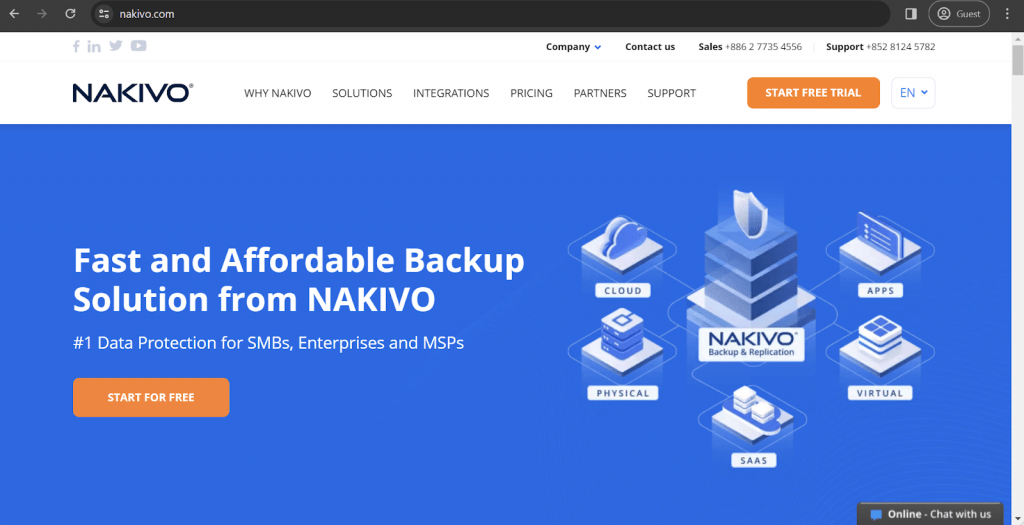
As a backup and recovery solution for various use cases, NAKIVO recognizes every backup storage type’s needs and unique characteristics. This includes tape storage, for which NAKIVO can offer full support. A native backup-to-tape can be performed using the software in question, offering incremental and full backup types and complete automation for the entire process. NAKIVO’s capability to cover many other backup and recovery use cases that do not involve tape makes it an excellent option for large enterprises with complex internal structures.
Customer ratings:
- Capterra – 4.8/5 stars based on 355 customer reviews
- TrustRadius – 9.4/10 stars based on 165 customer reviews
- G2 – 4.7/5 stars based on 204 customer reviews
Advantages:
- NAKIVO may be a feature-rich backup solution, but its interface is simple and easy to work with.
- Setting up NAKIVO for the first time is an easy process that practically anyone can perform.
- NAKIVO’s customer support team has gathered many positive reviews over the years, citing their usefulness and efficiency.
Disadvantages:
- A high price for large-scale backup software is uncommon, and NAKIVO is no exception in this department.
- NAKIVO’s minimal error logging capabilities offer little information about the issue.
- The solution has separate versions for Windows and Linux, but no feature parity exists. The Linux version is much more limited in capabilities than the Windows version.
Pricing (at the time of writing):
- NAKIVO’s pricing can be split into two main groups:
- Subscription-based licenses:
- “Pro Essentials” – from $1.95 per month per workload, covers most common backup types such as physical, virtual, cloud and NAS, while also offering instant granular recovery, virtual and cloud replication, storage immutability, and more
- “Enterprise Essentials” – from $2.60 per month per workload, adds native backup to tape, deduplication appliance integration, backup to cloud, as well as 2FA, AD integration, calendar, data protection based on policies, etc.
- “Enterprise Plus” does not have public pricing available, it adds HTTP API integration, RBAC, Oracle backup, backup from snapshots, and other features
- There is also a subscription available for Microsoft 365 coverage that costs $0.80 per month per user with an annual billing and can create backups of MS Teams, SharePoint Online, Exchange Online, OneDrive for Business, and more
- Another subscription from NAKIVO is its VMware monitoring capability that comes in three different forms:
- “Pro Essentials” for $0.90 per month per workload with CPU, RAM, disk usage monitoring and a built-in live chat
- “Enterprise Essentials” for $1.15 per month per workload that adds AD integration, 2FA capability, multi-tenant deployment, and more
- “Enterprise Plus” with no public pricing that adds RBAC and HTTP API integrations
- Perpetual licenses:
- Virtual environments:
- “Pro Essentials” for $229 per socket, covers Hyper-V, VMware, Nutanix AHV, and features such as instant granular recovery, immutable storage, cross-platform recovery, etc.
- “Enterprise Essentials” for $329 per socket, adds native backup to tape, backup to cloud, deduplication, 2FA, AD integration, and more
- “Enterprise Plus” with no public pricing that adds RBAC and HTTP API integrations, as well as backup from storage snapshots
- Servers:
- “Pro Essentials” for $58 per server, covers Windows and Linux, and features such as immutable storage, instant P2V, instant granular recovery, etc.
- “Enterprise Essentials” for $329 per server, adds native backup to tape, backup to cloud, deduplication, 2FA, AD integration, and more
- “Enterprise Plus” with no public pricing that adds RBAC and HTTP API integrations
- Workstations:
- “Pro Essentials” for $19 per workstation, covers Windows and Linux, and features such as immutable storage, instant P2V, instant granular recovery, etc.
- “Enterprise Essentials” for $25 per workstation, adds native backup to tape, backup to cloud, deduplication, 2FA, AD integration, and more
- “Enterprise Plus” with no public pricing that adds RBAC and HTTP API integrations
- NAS:
- “Pro Essentials” for $149 per one Terabyte of data, can backup NFS shares, SMB shares, folders on shares, and offer file level recovery
- “Enterprise Essentials” for $199 per one Terabyte of data, adds AD integration, 2FA support, calendar, multi-tenant deployment, etc.
- “Enterprise Plus” with no public pricing that adds RBAC and HTTP API integrations
- Oracle DB:
- “Enterprise Plus” is the only option available for Oracle database backups via RMAN, it can offer advanced scheduling, centralized management, and more
- VMware monitoring:
- “Pro Essentials” for $100 per socket with CPU, RAM, disk usage monitoring and a built-in live chat
- “Enterprise Essentials” for $150 per socket that adds AD integration, 2FA capability, multi-tenant deployment, and more
- “Enterprise Plus” with no public pricing that adds RBAC and HTTP API integrations
- Virtual environments:
My personal opinion on NAKIVO:
NAKIVO is a well-rounded backup and recovery software with plenty of capabilities. It supports many different storage types and can offer exceptional customer support. It provides complete support for tape backups, offering native backup and recovery task integration with full and incremental backup types. NAKIVO does have a confusing price structure, and its error-logging capabilities are somewhat basic. As such, further research about the software’s advantages and shortcomings is always recommended for complex solutions like these.
Zmanda
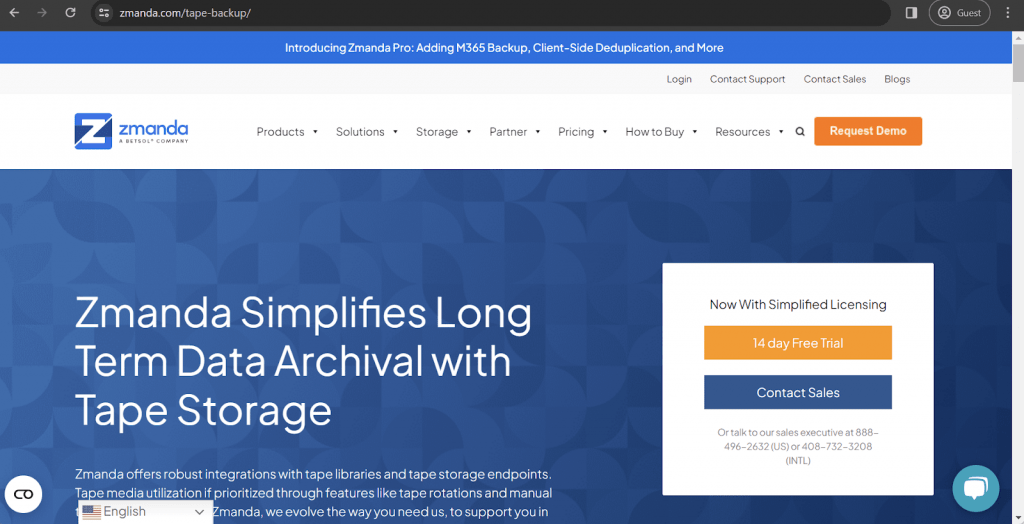
The BETSOL team is the current owner of Zmanda (Amanda Enterprise). This software provider offers different software applications such as database and cloud backup. Zmanda also supports tape storage as a backup target, making it possible to manage tape media as backup storage. The software can offer manual tape configuration capabilities, tape rotations, and integration with Zmanda Management Console. Easy scaling and extensive vaulting are also good examples of Zmanda’s tape backup capabilities.
Key features:
- Zmanda can offer several customization options for backup and recovery tasks, such as file/folder filtering to exclude some parts of the system from the backup or restore process.
- Zmanda’s reporting capabilities starkly contrast most of the significant solutions on the market, offering detailed reports full of helpful information about instances and processes.
- Support for incremental backups makes it possible to save a lot of storage space in the long run by making backups smaller.
Pricing (at the time of writing):
- One of Zmanda’s most significant selling points is low pricing when compared directly with the competition. As such, Zmanda has a reasonably simple pricing system that includes:
- $29.99 per physical server per month
- $2.99 per workstation per month
- $5.99 per VM per month
- $20 per 1 TB of cloud storage per month
- However, this particular option only applies to Zmanda Endpoint Backup and Recovery (Zmanda EBR).
- Other backup solutions (such as Zmanda Recovery Manager) do not have any public pricing available on the official website; requesting a personalized quote is the only way to obtain such information.
- Fortunately, Zmanda’s tape backup capabilities are included in Amanda Enterprise’s offering, and a dedicated pricing calculator page is available for basic price estimation.
My personal opinion on Zmanda:
Zmanda is a commercial version of AMANDA – a free and open-source backup solution with extensive capabilities. Zmanda expands upon AMANDA’s capabilities in many ways, but it is also a paid solution. In all fairness, Zmanda EBR is considered cheap compared to big backup solutions on the market. It also supports tape backup, among other features. Zmanda’s tape backup capabilities cover tape rotation, tape configuration, two backup types, and an easy management interface with a centralized dashboard. It is not the most user-friendly solution, but its price-to-feature set ratio is good enough for many smaller businesses.
EaseUS Todo Backup
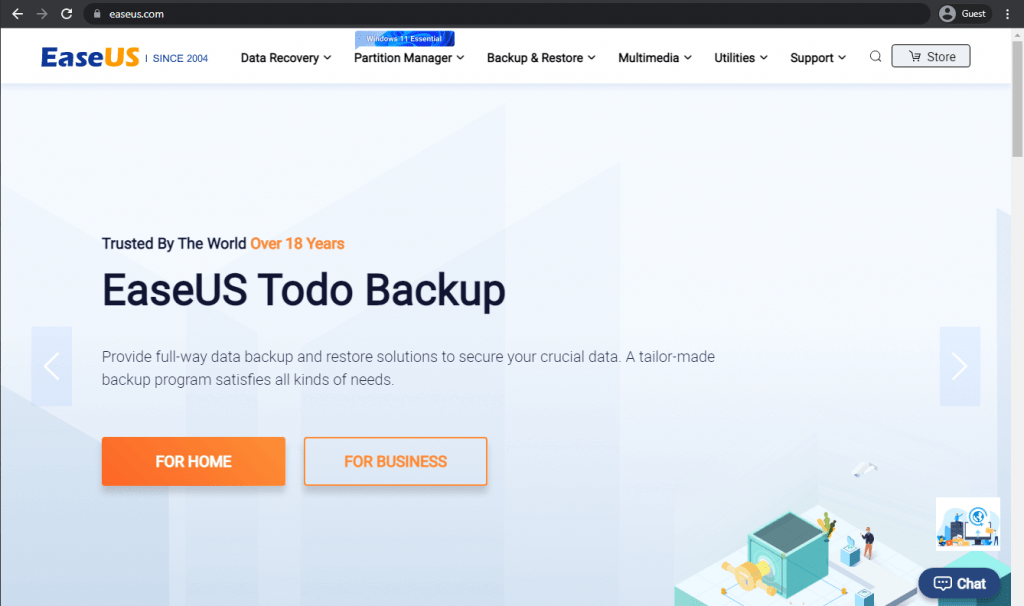
EaseUS is an entire family of products offering multiple different software appliances for partition management, data recovery, data transfer, and backups. EaseUS Todo Backup is a versatile backup solution with many useful backup-related features, including supporting tape as a backup location, incremental backups, one-click backup/recovery operations, extensive scheduling, and many other features for both regular users and businesses.
Customer ratings:
- Capterra – 4.5/5 stars based on 93 customer reviews
- TrustRadius – 8.0/10 stars based on 13 customer reviews
Key features:
- EaseUS can offer quick backup restoration no matter the destination.
- Backups in EaseUS can be performed at a file level and on a disk level, offering a certain level of granularity.
- EaseUS supports three backup types: differential, incremental, and full.
Pricing (at the time of writing):
- Since EaseUS Todo Backup is targeting individuals with its backup solution, first and foremost, the basic version of the software is entirely free.
- However, the Business version of the software has a price tag, and it may change depending on the client’s needs (more information on this page).
- Covering a single workstation adds $49 per year to the price tag.
- Coverage for one server costs $199 per year.
- The advanced version of the server coverage feature with Exchange and SQL Server backup features costs $299 annually.
- A multi-device license for technicians has a different pricing system.
- $999 for one year of coverage.
- $1,399 for two years of coverage.
- $2,499 for a lifetime coverage license.
- There is also pricing for the EaseUS Backup Center that could be found on the same page, but it is less relevant to our subject, so it would not be covered here.
My personal opinion on EaseUS Todo Backup:
EaseUS Todo Backup puts much effort into being promoted as a backup solution for individuals. The Free version is often the first the average user encounters on the official EaseUS website. The Business version of this solution expands the feature set and improves existing capabilities, but it has a price tag. The software can perform various backup and recovery operations, from data encryption and disk cloning to saving backups on practically any storage type (including tape storage). There are not many features that Todo Backup can provide for tape storage specifically, but some of its core capabilities also operate with tape backups, creating a notable contender for this feature set.
Bacula Enterprise
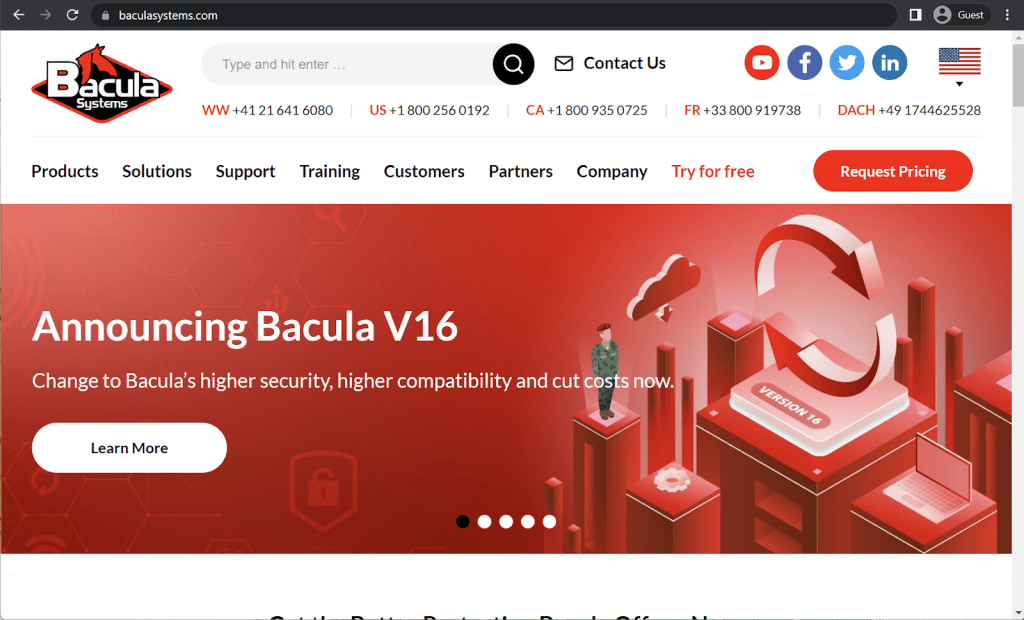
The Final example on this list is Bacula Enterprise. This multifunctional backup solution supports an abundance of different storage types and backup techniques with the help of its modular system.
Bacula Enterprise offers an especially highly secure modular architecture that places it in the highest bracket of solutions regarding its security levels. Being especially compatible with tape storage technology is part of that security architecture for users with tape storage as part of their security strategy. Bacula also has some advanced tape-related features:
- Labeled Volumes, preventing accidental overwriting (at least by Bacula). Bacula Enterprise also supports IBM /ANSI tape labels, which are recognized by many enterprise tape-managing pieces of software
- Data spooling to disk during backup, with subsequent write-to-tape from the spooled disk files. This prevents tape “shoe shine” during Incremental/Differential backups
- Support for autochanger barcodes; automatic tape labeling from barcodes
- Automatic support for multiple autochanger magazines, either using barcodes or by reading the tapes
- Support for many de-facto storage standards, reducing likelihood of vendor lock-in and increasing sustainability options.
Customer ratings:
- TrustRadius – 9.8/10 points with 55 customer reviews
- G2 – 4.7/5 points with 56 customer reviews
Advantages:
- Bacula can offer support for an especially large range of storage types and variations, such as tape, disk, cloud, database, VM, and container.
- The software in question has impressive adaptability and agility, enabling it to be implemented in different internal systems and companies if necessary.
- One of the biggest focuses of Bacula Enterprise is the abundance of data security capabilities such as many global and granular encryption choices, core architecture security, backup verification, security monitoring tools, data poisoning detection, ransomware detection, SIEM integration, MFA, advanced immutability, auto-detection of any suspicious patterns, and much more.
Disadvantages:
- Bacula’s plugin system allows it to support many different storage types and file systems, but some specific modules are not included in the base package and require additional payment to be accessed.
- The first-time setup for Bacula Enterprise is a process that may not be fast nor easy, and the overall integration time would depend on how a client’s infrastructure operates.
- Some users may find getting into Bacula challenging although it helps that it can only be controlled by both GUI and/or CLI. The command line interface (CLI) is an option that offers more control and customization but also requires some level of knowledge to operate it properly. On the other hand, the GUI is a web-based interface that still needs some familiarization for first-time users due to the many features offered. At the time of writing however, Bacula is poised to introduce a simplified, role-based alternative.
Pricing (at the time of writing):
- Bacula Systems provides a range of pricing tiers for Bacula Enterprise, catering to different needs:
- BSBE (Bacula Small Business Edition):
- Includes BWeb and web support.
- Limited to 2 contracts and 20 agents.
- Standard:
- Supports up to 50 agents and 2 contracts.
- Adds support answer deadlines ranging from 1 to 4 business days.
- Bronze:
- Accommodates up to 200 agents and 2 contracts.
- Offers phone support and shorter customer support answer deadlines (from 6 hours to 4 days).
- Silver:
- Supports up to 500 agents and 3 contracts.
- Introduces a deduplication plugin and lowers customer support answer deadlines (from 4 hours to 2 days).
- Gold:
- Supports up to 2000 agents and 5 contracts.
- Drastically reduces customer support answer deadlines (from 1 hour to 2 days).
- Platinum:
- Supports up to 5000 agents and 5 contracts.
- Offers PostgreSQL catalog support.
- Includes one training seat per year for Administrator courses.
- BSBE (Bacula Small Business Edition):
- The official pricing details are not publicly available, but unofficial sources suggest that Bacula Enterprise’s monthly pricing may start at $500.
- For precise and detailed pricing information, it is recommended to contact Bacula Systems directly.
Here are some examples of tape libraries and autoloaders that are known to work with Bacula Enterprise tape backup software:
- DELL PowerVault TL4000
- Qualstar RLS-8450
- StorageTek L180
- Oracle StorageTek SL500
- Oracle StorageTek SL3000
The exact specifics of how Bacula Enterprise Storage Daemon handles tape backup would be discussed below.
Tape backup with Bacula Enterprise
The Bacula Enterprise Storage Daemon is the component that manages reads and writes to the various storage devices supported by Bacula. Native Linux tools partially control tape backup; therefore, supported devices largely follow support in the Linux kernel. For information about whether a specific tape library or drive is supported by Bacula Enterprise, Bacula Systems’ support can answer the question. However, nearly all commercially available tape libraries and drives that are supported by Linux and other kernels are supported by Bacula.
While most tape backup and recovery drives will work with minimal configuration, there are some main things to be aware of for the best possible performance and reliability. Bacula Enterprise has a web interface (BWeb) that greatly simplifies setup and provides sensible defaults. It’s good to understand what is happening in the configuration files.
Creating and configuring tape autochangers with BWeb
To understand how BWeb manages the creation and configuration of autochangers, please watch the video here: https://www.youtube.com/watch?v=_HZ-lnt4vg0 . This video is related to installing a deduplicating disk autochanger, but the same wizard and process are used to install tape devices. The following information should help fill in any gaps when setting up a tape autochanger, or allow you to set up tape autochangers without the help of BWeb.
By default, Bacula Enterprise is installed with many functional example configurations. There’s a tape autochanger (Bacula uses the word autochanger to describe the tape library) that should look like the one below.
#
#Autochanger {
# Name = Autochanger
# Device = Drive-1
# Device = Drive-2
# Changer Command = “/opt/bacula/scripts/mtx-changer %c %o %S %a %d”
# Changer Device = /dev/sg0
#}
#Device {
# Name = Drive-1 #
# Drive Index = 0
# Media Type = DLT-8000
# Archive Device = /dev/nst0
# AutomaticMount = yes; # when device opened, read it
# AlwaysOpen = yes;
# RemovableMedia = yes;
# RandomAccess = no;
# AutoChanger = yes
# #
# # New alert command in Bacula Enterprise 8.8.0
# # Note: you must have the sg3_utils (rpms) or the
# # sg3-utils (deb) installed on your system.
# # and you must set the correct control device that
# # corresponds to the Archive Device
# Control Device = /dev/sg?? # must be SCSI ctl for /dev/nst0
# Alert Command = “/opt/bacula/scripts/tapealert %l”
#
# #
# # Enable the Alert command only if you have the mtx package loaded
# # Note, apparently on some systems, tapeinfo resets the SCSI controller
# # thus if you turn this on, make sure it does not reset your SCSI
# # controller. I have never had any problems, and smartctl does
# # not seem to cause such problems.
# #
# Alert Command = “sh -c ‘tapeinfo -f %c |grep TapeAlert|cat'”
# If you have smartctl, enable this, it has more info than tapeinfo
# Alert Command = “sh -c ‘smartctl -H -l error %c'”
#}
#Device {
# Name = Drive-2 #
# Drive Index = 1
# Media Type = DLT-8000
# Archive Device = /dev/nst1
# AutomaticMount = yes; # when device opened, read it
# AlwaysOpen = yes;
# RemovableMedia = yes;
# RandomAccess = no;
# AutoChanger = yes
# # Enable the Alert command only if you have the mtx package loaded
# Alert Command = “sh -c ‘tapeinfo -f %c |grep TapeAlert|cat'”
# If you have smartctl, enable this, it has more info than tapeinfo
# Alert Command = “sh -c ‘smartctl -H -l error %c'”
#}
Let’s break this down a bit. We would need to make just a few changes for a better configuration. First, it should have a better name to avoid confusion in the future. The device names here can also change to match, as they are just references to the device resources we’ll look at next. Next, it’s best to use the udev device name rather than the ‘/dev/sgX’ device path, as the udev name will never change on a reboot. So that will look like ‘/dev/tape/by-id/scsi-xxxxxxxxxxxx’ The changer command usually doesn’t need to change, and you can view the script in ‘/opt/bacula/scripts/’ if you want to see how it works. So the example below is closer to a production config:
#
#Autochanger {
# Name = HPLTOLib1
# Device = HPLTOLib1-Drive-1
# Device = HPLTOLib1-Drive-2
# Changer Command = “/opt/bacula/scripts/mtx-changer %c %o %S %a %d”
# Changer Device = /dev/tape/by-id/scsi-xxxxxxxxxxxx
#}
Next, let’s look at the tape devices. As with the autochanger itself, we’ll want to rename the devices so it’s clear which device ‘owns’ them. In this case, the names must match those in the autochanger config. We’ll also want to use the udev persistent names, as shown below. The drive index is important; when mtx-changer issues a command such as ‘load tape x into drive y’, it uses the drive index from this device setting to determine where the tape will go. So, this must match what the library understands as drive numbering. It frequently starts with drive 0.
The Media Type is an arbitrary designation given to devices within a tape library to tell Bacula which devices can be called to operate which tapes. Tapes are labeled with a media type as well. For example, suppose you have two LTO-7 tape drives in Library A and two in Library B. It may be best to give them different media types so that Bacula doesn’t request a mount from Library A to Library B. In this case, we’ll bind the media type to the autochanger.
Always Open means that Bacula will not rewind the tape after each write session, but leave the drive ready for the next append. Automatic Mount means exactly what it sounds like. Bacula will mount and use the tape devices without user intervention. Removable Media tells Bacula that the media may not always be available in the autochanger and changes the behavior when a new tape is needed. Random Access is set to ‘no’ as tapes are read and written linearly, and finally, Bacula needs to know that the device is a member of an autochanger. Bacula Enterprise can also use the sg3-utils packages to send tape alerts and monitoring commands and alert you if a drive shows errors. So the config below is pretty good and can be copied to the second drive with just a change to the name, drive index, and archive device.
# Name = HPLTOLib1-Drive-1 #
# Drive Index = 0
# Media Type = HPLTOLib1-LTO-7
# Archive Device = /dev/tape/by-id/scsi-xxxxxxx-nst
# AutomaticMount = yes; # when device opened, read it
# AlwaysOpen = yes;
# RemovableMedia = yes;
# RandomAccess = no;
# AutoChanger = yes
# Maximum Block Size = xxxxxxxx
# Maximum File Size = xxx
# #
# # New alert command in Bacula Enterprise 8.8.0
# # Note: you must have the sg3_utils (rpms) or the
# # sg3-utils (deb) installed on your system.
# # and you must set the correct control device that
# # corresponds to the Archive Device
# Control Device = /dev/sg?? # must be SCSI ctl for /dev/nst0
# Alert Command = “/opt/bacula/scripts/tapealert %l”
#
With the above, we could have a working configuration to load, unload, read, and write volumes. What are the next steps? First, a command line tool called ‘btape’ should be run before putting anything into production. btape can offer commands to test the autochanger, test writing a full tape, perform testing tools, and ensure it can be read back. A successful run of the ‘btape test’ for each device and ‘btape autochanger’ should be considered a minimum requirement.
Finally, for performance, the ‘maximum block size’ and ‘maximum file size’ should be set for each device. The values here that will yield the best performance depend mostly on the tape drive technology. BWeb sets sensible defaults, or Bacula Systems Support can also provide them. Block sizes usually range between 64 and 512k, and file sizes range from 1 to 5 GB. It’s best to get the current recommendations from Bacula Systems Support when possible and then apply them and test using the btape speed test. Please note that block sizes can’t be changed easily once in production, so take the time to test beforehand.
Conclusion
Tape storage is a highly valuable member of the storage technology community. It continues to grow and evolve, offering stable, sustainable and extensive storage for different data types and use cases.
One of the most common examples of tape backup usefulness is in relation to the 3-2-1 rule. There needs to be at least one copy of a company’s data stored offsite, and tape storage presents a perfect opportunity for this kind of use case – a special type of storage that can be turned off most of the time, making it practically impervious to tampering.
Tape storage is still relevant and will remain relevant. We hope this article managed to satisfy your curiosity about tape: general information, lists of advantages and shortcomings, or even our list of best tape backup software solutions on the market.
Hopefully, this has also been a helpful overview of how to set up tape backup software in Bacula. The Bacula Main Manual has detailed information about each configuration option and more example configurations. For Bacula Enterprise customers, don’t hesitate to contact support with questions as you set up tape devices.



Where and how are Bacula Systems training courses for system administrators conducted? How can I get there if know only Bacula Community?
Hello Nikolai,
It’s not a problem if you were only working with community edition. Our trainings (especially the basic Admin 1) is based on Bacula Community. Assuming that you’re interested specifically on tape backup I can assure you that the training includes this specific topic. You can register for the nearest one at https://www.baculasystems.com/bacula-administrator-i-training-course/.
I keep all the information on the disc, it’s cheap. Should I switch to tapes instead?
Alain, I think you should have both storage options. Disk can be useful for fast restores while tape is usually used in case of a disaster.
can backula move existing backup jobs from say LTO4 tapes to LTO7 tapes so that all backup jobs are now on LTO7 and retire the LTO4 drives?
Hi Kevin. Yes, Bacula Enterprise and Community can do this. You should use migration job between LTO4 and LTO7 tapes. Please check the Main Manual here about Migration job (https://www.bacula.org/13.0.x-manuals/en/main/Migration_Copy.html) and if you have further question, please reach out to the Bacula Community mailing list or subscribe to our Enterprise support services.